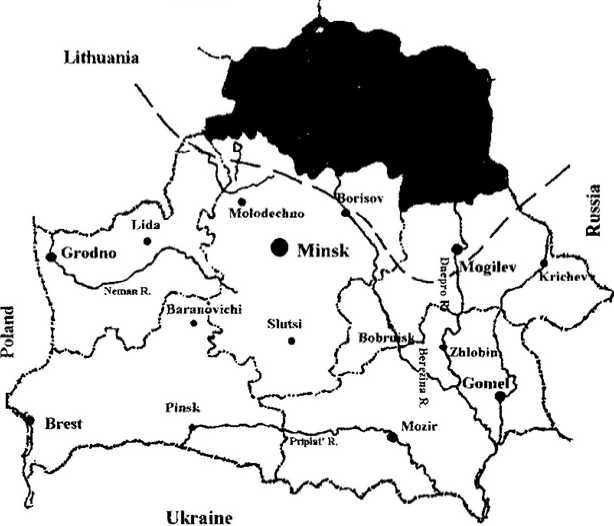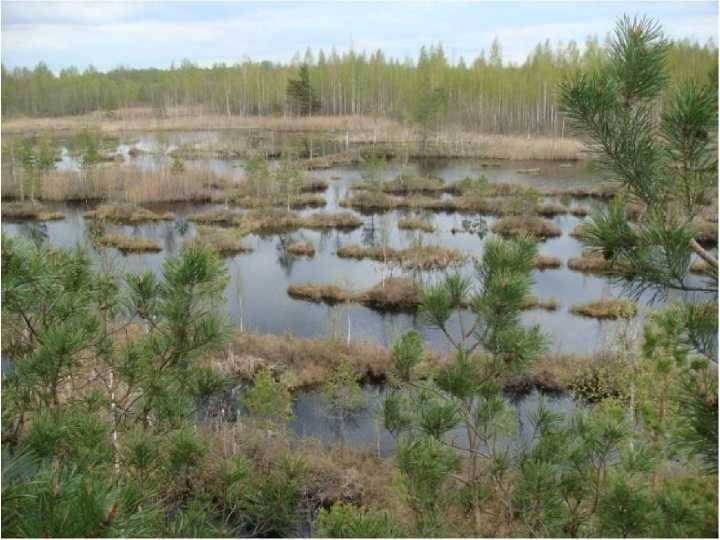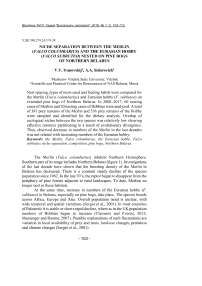Niche separation between the merlin (Falco columbarius) and the Eurasian hobby (Falco subbuteo) nested on pine bogs of Northern Belarus
Автор: Ivanovskij V.V., Sidorovich A.A.
Журнал: Вестник Тверского государственного университета. Серия: Биология и экология @bio-tversu
Рубрика: Зоология
Статья в выпуске: 1, 2018 года.
Бесплатный доступ
Nest spacing, types of nests used and feeding habits were compared for the Merlin ( Falco columbarius ) and Eurasian hobby ( F. subbuteo ) on extended pine bogs of Northern Belarus. In 2008-2017, 60 nesting cases of Merlins and 20 nesting cases of Hobbies were analyzed. A total of 381 prey remains of the Merlin and 336 prey remains of the Hobby were sampled and identified for the dietary analysis. Overlap of ecological niches between the two species was relatively low showing effective resource partitioning in a result of evolutionary divergence. Thus, observed decrease in numbers of the Merlin in the last decades was not related with increasing numbers of the Eurasian hobby.
Merlin, falco columbarius, the eurasian hobby, falco subbuteo, niche separation, competition, pine bogs, northern belarus
Короткий адрес: https://sciup.org/146279481
IDR: 146279481 | УДК: 598.279.24:574.38
Текст научной статьи Niche separation between the merlin (Falco columbarius) and the Eurasian hobby (Falco subbuteo) nested on pine bogs of Northern Belarus
The Merlin (Falco columbarius) inhabits Northern Hemisphere. Southern part of its range includes Northern Belarus (figure 1). Investigations of the last decade have shown that the breeding density of the Merlin in Belarus has decreased. There is a constant steady decline of the species population since 1962. In the late 70’s, the raptor began to disappear from the periphery of pine forests adjacent to rural landscapes. To date, Merlins no longer nest in these habitats.
At the same time, increase in numbers of the Eurasian hobby (F. subbuteo) in Belarus, especially on pine bogs, take place. The species breeds across Africa, Europe and Asia. Overall population trend is unclear, with wide temporal and spatial variations (Sergio et al., 2001). In most countries of Palearctic it is stable or shows rapid decline, where as in the UK population numbers of Hobbies began to increase (Clements and Everett, 2012; Messenger and Roome, 2007). Possible explanations of such fluctuations are variation in local availability of prey and nests, land-use changes, predation and climate changes (Sergio et al., 2001).
То evaluate niche separation and test the hypothesis of competitive displacement of the Merlin by the Hobby, we investigated 60 nesting cases of Merlins and 20 nesting cases of Hobbies on pine bogs and developed peat quarries.
Data were obtained in 2008-2017 on extended pine bogs in Northern Belarus (figure 1). Hilly relief originated from the last Menapian glaciation and (Матвеев и др., 1988). The territory belongs to the coniferous-smallleaved European forest zone. Total study area is comprised about 2548,5 km2. It is situated in Vitsebsk districts of the Vitsebsk region and called Belarusian Poozerje (figure 1). It represented patches of alternating pine bogs (figure 2) and abandoned developed peat quarries (figure 3) that were secondarily swamped in result of artificial increasing of a groundwater level. There, peat was extracted by excavating, and now these lands look like alternating patches of stretched islets grown with depressed Pines (Pinus sylvestris) and Moor birches (Betula pubescens) and trenches (up to 1 m deep) at different stages of overgrowing. These pine bogs and peat quarries are surrounded by a rural area intensively used for agricultural needs and dry coniferous-smallleaved forests.
Latvia

Fig. 1. Study area (Belarusian Poozerje) and southern border of the Merlin breeding range (dash line)
Рис. 1 . Место проведения исследований (Белорусское Поозерье) и южная граница ареала дербника (пунктирная линия)
Fig.

Fig. 2. Typical ridge-hollow pine bogs, Vitebsk region, Northern Belarus Рис. 2 . Типичный грядово-мочажинный комплекс на верховом болоте, Витебская обл., Северная Беларусь

3 . Swamped developed peat quarries, Vitebsk region, Northern Belarus Рис. 3 . Выработанные и подтопленные торфокарьеры, Витебская обл., Северная Беларусь
The climate is humid continental. Winters are variable with alternating periods of severe frosts below -20°C and thaws lasting for some weeks. Usually snow cover persists for at least 1.5-2 months, with a maximum depth of 30-90 cm.
The study area was characterized by dense nesting of the Hooded crow (Corvus cornix) producing 40-50 nests annually, that was important for the Hobby.
A total of 381 prey remains of the Merlin and 336 prey remains of the Hobby were sampled in May-July and identified. Small mammal identification was done by determination of their skulls (Pucek, 1981). Other components were analyzed using the published keys of feathers and bones of birds, bones of amphibians, bones and skin scales of reptiles (Bohme, 1977; Marz, 1987; Brown et al., 1999). Insects were distinguished by the remains of exoskeleton. To obtain the percentage of food biomass consumed (hereafter, %Bc), the number of prey individuals were multiplied by the mean body mass of that prey (Pucek, 1981; Sidorovich, 2011).
Dietary diversity (trophic niche breadth) was calculated using the Levins’ index В (Levins 1968):
B = vyPi2
where pi - fraction food item z is of the total biomass consumed by raptors. The calculation was performed for 39 food categories. Therefore, the В index varies from 1 (the narrowest niche) to 39 (the broadest niche possible). The simplified Morisita’s index Ch (after Krebs 1998) was used to compare diets:
H x^w 9 7
EPij+Z^
where py - fraction food item i is of the total biomass consumed by the species j (the Merlin); p;k - fraction food item i is of the total biomass consumed by the species k (the Hobby); z = 1, 2, 3,..., n; n - total number of food items. The index varies between 0 (exclusive niches) and 1 (complete overlap). According to the value of this index, we formally fixed three levels of dietary overlap, with 0-0.33 representing small overlap, 0.34-0.66 as moderate overlap and 0.67-1.0 as large overlap.
The replicated goodness-of-fit G-test was used to reveal significant differences between two diet compositions (Sokal and Rohlf 1995). Most of the statistical calculations were carried out using ASPID/GT software (Grigyantz 1993).
Southern border of the Merlin’s range is shown on figure 1 by dashed line. First survey to estimate population size of the Merlin in Belarusian Poozerje was performed in 1979 and gave 250-300 breeding pairs (Дорофеев, Ивановский, 1980). In 2011, there was a decrease in the numbers of the species to 220-250 breeding pairs (Ивановский, 2012). In 2014-2017, for the first time in 40 years of observations, the Merlin did not nest on the developed and abandoned quarries, and its total numbers was estimated to be 200-220 breeding pairs. It was not the case of spatial redistribution, since in the most favorable breeding habitats (large pine bogs) we did not notice increase in the nesting density of this falcon. Thus, there is an obvious population decline of the Merlin in Belarus with reduction of the species range on its southern border (Ивановский, 2016). For the last 50 years, in this region nesting range of the species turned from “continuous” to “island”, and nesting sites remained only on extended pine bogs.
The Hobby occurs everywhere in Belarus. The numbers of the species constantly increase. In 2001, we counted 550-600 breeding pairs in Belarusian Poozerje (Ивановский, 2012). In 2017 it was 620-650 pairs.
Analysis of nest spatial distribution showed that Merlins preferred to nest in ridges with pines among bogs and abandoned developed peat quarries, whereas Hobbies basically used dry pine forests along edges of pine bogs (table 1). Revealed differences were statistically significant (G=89,692; p <0,001), however Morisita’s index Ch of niches’ overlap was equalled 0,49 showing middle overlap. Hobbies used nests on a height 5-22 m, on average 11,8±1,33 m, from the ground. Merlins preferred nests at lower heights - 012 m, on average 5,4±0,35 m.
Middle overlap (Ся=0,48) was revealed for a type of nest used by Merlins and Hobbies (table 2). Merlins used a lot artificial nests provided by us, Hobbies preferred nests constructed by Corvids (G=122,87; p <0,001). Niche breadths for this parameter were near the same for both species - 2,89 for the Merlin and 3,28 for the Hobby.
Also, a comparative analysis of diet compositions of the Merlin and the Hobby in the nesting period on pine bogs and peat quarries was carried out (table 3). The calculations took into account absolutely all food categories in % of biomass consumed (% BC), found in diets of the Merlin and the Hobby.
The food niche breadth of the Merlin was 6.6, while of the Hobby it comprised 7.7. The overlap of the niches in % BC was 0.357, that means middle close to insignificant overlap. Occasionally noted conflicts between Merlins and Hobbies are, plausibly, the phenomena of kleptoparasitism, when stronger Hobbies try to take away the prey from Merlins.
Table 1 Nest spacing of the Merlin (n=60) and the Hobby (n=20) on extended pine bogs, Vitebsk region, Northern Belarus
Таблица 1
Пространственное распределение гнезд дербника (п=60) и чеглока (п=20) на верховых болотах, Витебская обл., Северная Беларусь
|
Nesting site (at 25 m distance around a nest) |
% of nesting sites |
|
|
the Merlin |
the Hobby |
|
|
Islands and cusps among pine bogs |
3 |
4 |
|
Dry pine forests along edges of pine bogs |
25 |
45 |
|
Dry pine forests along shores of vestigial lakes |
4 |
5 |
|
Ridges with pines among bogs |
37 |
5 |
|
Abandoned developed peat quarries |
29 |
5 |
|
Heather bushes on burners |
1 |
0 |
|
Levins’ index В of niche breadth |
2,53 |
2,2 |
|
G-test |
89,692 (p <0,001) |
|
|
Morisita’s index Ch of niches’ overlap |
0,49 |
|
Table 2
Types of nests used by the Merlin (n=60) and the Hobby (n=20) for breeding on extended pine bogs, Vitebsk region, Northern Belarus
Таблица 2
Типы гнезд, используемых дербником (п=60) и чеглоком (п=20) для размножения на верховых болотах, Витебская обл., Северная Беларусь
|
Type of a nest |
% of nests |
|
|
the Merlin |
the Hobby |
|
|
Nest of the Common raven (Corvus corax) |
0,0 |
35 |
|
Nest of the Hooded crow (C. cornix) |
26,7 |
40 |
|
Nest of the Golden eagle (Aquila chrisaetos) |
0,0 |
10 |
|
Nest of the Osprey (Pandion haliaetus) |
3,3 |
5 |
|
Artificial nest “bucket” |
48,3 |
10 |
|
Artificial nest “hummock” |
20,0 |
0 |
|
Nest on the ground |
1,7 |
0 |
|
Levins’ index В of niche breadth |
2,89 |
3,28 |
|
G-test |
122,87 (p<0,001) |
|
|
Morisita’s index Ch of niches’ overlap |
0,48 |
|
Table 3
Diet composition of the Hobby and Merlin in the breeding period on extended pine bogs, Vitebsk region, Northern Belarus
Таблица 3
Состав рациона чеглока и дербника в период размножения на верховых болотах, Витебская обл., Северная Беларусь
|
Food category |
the Hobby |
the Merlin |
||
|
Number of prey items |
%BC |
Number of prey items |
%BC |
|
|
Beetles |
— |
— |
73 |
2,5 |
|
Dragonflies |
— |
— |
175 |
4,2 |
|
Rodent sp. |
11 |
1Д |
9 |
7,8 |
|
Bat sp. |
1 |
0,1 |
20 |
18,3 |
|
Eurasian collared dove |
— |
— |
2 |
10,5 |
|
Common swift |
— |
— |
3 |
4,2 |
|
Great reed warbler |
— |
— |
1 |
1,5 |
|
Lark sp. |
— |
— |
7 |
10,2 |
|
Crossbill sp. |
1 |
0,2 |
— |
— |
|
Eurasian bullfinch |
1 |
0,1 |
— |
— |
|
Common rosefinch |
1 |
0,1 |
— |
— |
|
Northern wheatear |
1 |
0,1 |
— |
— |
|
Thrush nightingale |
1 |
0,1 |
— |
— |
|
European goldfinch |
1 |
0,1 |
— |
— |
|
European greenfinch |
5 |
0,7 |
— |
— |
|
Common chaffinch |
7 |
0,7 |
— |
— |
|
Sparrow sp. |
15 |
1,9 |
— |
— |
|
Wagtail sp. |
11 |
1,1 |
— |
— |
|
Great grey shrike |
5 |
1,1 |
— |
— |
|
Red-backed shrike |
4 |
0,9 |
1 |
1,9 |
|
Tree pipit |
12 |
1,3 |
— |
— |
|
Meadow pipit |
27 |
2,4 |
2 |
1,5 |
|
Swallow sp. |
3 |
0,2 |
30 |
21,9 |
|
Yellowhammer |
9 |
1,2 |
3 |
3,4 |
|
Small bird sp. |
131 |
18,6 |
10 |
12,1 |
|
Hasel grouse |
1 |
1,8 |
— |
— |
|
Common moorhen |
1 |
1,4 |
— |
— |
|
Wood sandpiper |
7 |
2,3 |
— |
— |
|
Common greenshank |
5 |
4,0 |
— |
— |
|
Great snipe |
2 |
1,7 |
— |
— |
|
Common snipe |
6 |
ЗД |
— |
— |
|
Eurasian curlew |
3 |
13,5 |
— |
— |
|
Woodpecker sp. |
8 |
2,7 |
— |
— |
|
Whinchat |
1 |
0,1 |
— |
— |
|
Fieldfare |
1 |
0,7 |
— |
— |
|
Redwing |
1 |
0,2 |
— |
— |
|
Mistle thrush |
1 |
0,6 |
— |
— |
|
Song thrush |
8 |
2,7 |
— |
— |
|
European starling |
85 |
30,2 |
— |
— |
|
Eurasian jay |
4 |
3,0 |
— |
— |
|
Total |
381 |
100 |
336 |
100 |
|
Levins’ index В of niche breadth |
6,6 |
7,7 |
||
Thus, overlapping of ecological niches of the Merlin and the Hobby, nesting on pine bogs and peat quarries, for all analyzed parameters is not significant. We did not reveal relationship between a decline of the Merlin population and an increase in the numbers of the Hobby. One can only assume that there are other factors affecting these processes. Further increase in the number of Hobbies on pine bogs is limited by the absence of free nests, which can significantly accelerate competition for available nests between Hobbies and Merlins in the future.
АНАЛИЗ ПЕРЕКРЫВАНИЯ ЭКОЛОГИЧЕСКИХ НИШ ДЕРБНИКОВ (FALCO COLUMBARIUM И ЧЕГЛОКОВ
(FALCO SUBBUTEO^ ГНЕЗДЯЩИХСЯ НА ВЕРХОВЫХ БОЛОТАХ СЕВЕРНОЙ БЕЛАРУСИ
В.В. Ивановский1, А.А. Сидорович2
Ивановский В .В. Анализ перекрывания экологических ниш дербников {Falco columbarius^ и чеглоков {Falco subbuteo^, гнездящихся на верховых болотах Северной Беларуси / В.В. Ивановский, А.А. Сидорович// Вести. ТвГУ. Сер. Биология и экология. 2018. № 1. С. 103-112.
Список литературы Niche separation between the merlin (Falco columbarius) and the Eurasian hobby (Falco subbuteo) nested on pine bogs of Northern Belarus
- Дорофеев А.М., Ивановский В.В. 1980. Экология сокола-дербника (Falco columbarius L.) в Белорусском Поозерье//Вестник зоологии. № 5. С. 62 -67.
- Ивановский В.В. 2012. Хищные птицы Белорусского Поозерья: Витебск: УО «ВГУ им. П.М. Машерова». 209 с.
- Böhme G. 1977. Zur Bestimmung quartärer Anuren Europas an Hand von Skelettelementen//Wiss. Z. Humboldt-Univ. Berlin. Math. Nat. R. 26: 283-300.
- Brown R., Ferguson J., Lees D. 1999: Tracks and Signs of the Birds of Britain and Europe. London: Christopher Helm Publishers Ltd. 232 p.
- Clements R.J., Everett C.M. 2012. Densities and dispersion of breeding Eurasian Hobbies Falco subbuteo in southeast England//Bird Study. № 59. P. 74-82.
- Grigyantz R.B. 1993. The software for informational and search systems with data bases of full-text documents of the heterogeneous structure (ASPID/GT) with applications for the statistical analysis (ECOPROG). Minsk: The Academy of Sciences of Belarus, the Computing Center.
- Ivanovsky V.V. 2016. Will the Merlin Disappear as a Breeding Species from Northern Belarus?//Raptors Conservation. № 32. P. 112-117.
- Krebs J.K. Ecological Methodology. 2-ond Ed. 1999. Oslo: Addison-Welsey Longman, Inc., 620 p.
- Levins R. 1968. Evolution in changing environments. Princeton: Princeton Univ. Press. 120 p.
- März R. 1987. Prey Remnants in Pellets and Scats of Predators. Berlin: Akademie Verlag. 288 p.
- Матвеев А.В., Гурский Б.Н., Левицкая Р.И. 1988. Рельеф Белоруссии. Мн.: Наука и Техника. 320 с.
- Messenger A., Roome M. 2007. The breeding population of the Hobby in Derbyshire.//British Bird. № 100. P. 594-608.
- Pucek Zd. 1981. Keys to Vertebrates of Poland Mammals. Warsaw: Polish Scientific Publishers. 367 p.
- Sergio F., Bijlsma R.G., Bogliani G., Wyllie I. 2001. Falco subbuteo Hobby//BWP Update. №3. P.133-156.
- Sidorovich V.E. 2011. Analysis of vertebrate predator-prey community. Minsk: Tesey. 736 p.
- Sokal R.R., Rohlf F.J. 1995. Biometry. The Principles and Practice of Statistics in Biological Research. New York: W.H. Freeman and company. 887 p.


